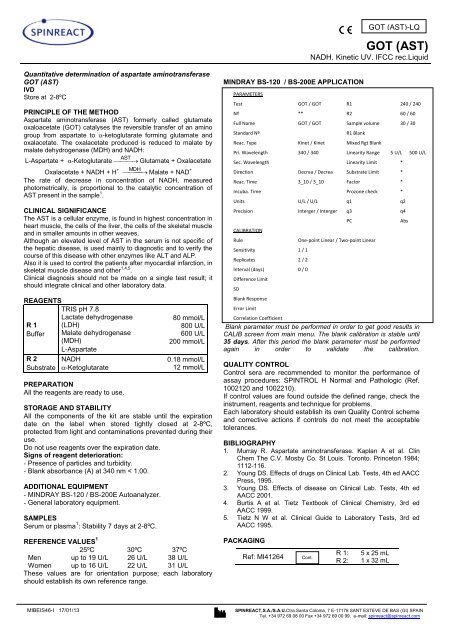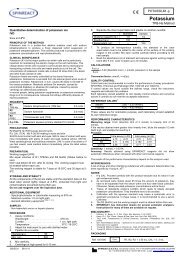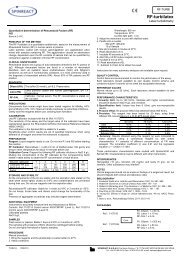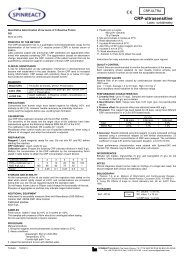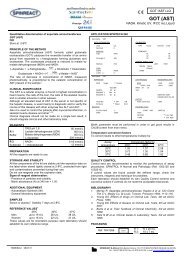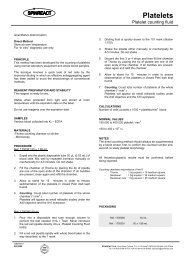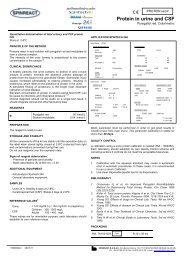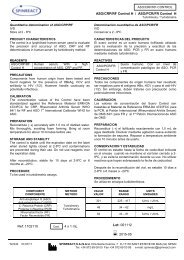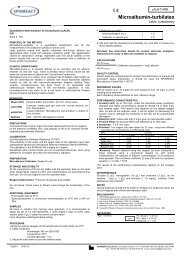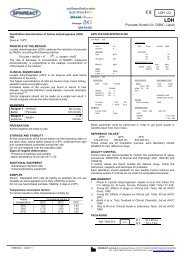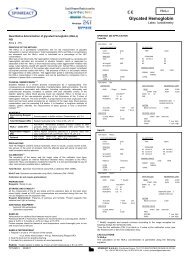GOT (AST)
GOT (AST) - Spinreact
GOT (AST) - Spinreact
- No tags were found...
You also want an ePaper? Increase the reach of your titles
YUMPU automatically turns print PDFs into web optimized ePapers that Google loves.
<strong>GOT</strong> (<strong>AST</strong>)-LQ<br />
<strong>GOT</strong> (<strong>AST</strong>)<br />
NADH. Kinetic UV. IFCC rec.Liquid<br />
Quantitative determination of aspartate aminotransferase<br />
<strong>GOT</strong> (<strong>AST</strong>)<br />
IVD<br />
Store at 2-8ºC<br />
PRINCIPLE OF THE METHOD<br />
Aspartate aminotransferase (<strong>AST</strong>) formerly called glutamate<br />
oxaloacetate (<strong>GOT</strong>) catalyses the reversible transfer of an amino<br />
group from aspartate to -ketoglutarate forming glutamate and<br />
oxalacetate. The oxalacetate produced is reduced to malate by<br />
malate dehydrogenase (MDH) and NADH:<br />
L-Aspartate + -Ketoglutarate <br />
<strong>AST</strong> <br />
Glutamate + Oxalacetate<br />
Oxalacetate + NADH + H + <br />
MDH <br />
Malate + NAD +<br />
The rate of decrease in concentration of NADH, measured<br />
photometrically, is proportional to the catalytic concentration of<br />
<strong>AST</strong> present in the sample 1 .<br />
CLINICAL SIGNIFICANCE<br />
The <strong>AST</strong> is a cellular enzyme, is found in highest concentration in<br />
heart muscle, the cells of the liver, the cells of the skeletal muscle<br />
and in smaller amounts in other weaves.<br />
Although an elevated level of <strong>AST</strong> in the serum is not specific of<br />
the hepatic disease, is used mainly to diagnostic and to verify the<br />
course of this disease with other enzymes like ALT and ALP.<br />
Also it is used to control the patients after myocardial infarction, in<br />
skeletal muscle disease and other 1,4,5 .<br />
Clinical diagnosis should not be made on a single test result; it<br />
should integrate clinical and other laboratory data.<br />
REAGENTS<br />
R 1<br />
Buffer<br />
R 2<br />
Substrate<br />
TRIS pH 7.8<br />
Lactate dehydrogenase<br />
(LDH)<br />
Malate dehydrogenase<br />
(MDH)<br />
L-Aspartate<br />
NADH<br />
-Ketoglutarate<br />
PREPARATION<br />
All the reagents are ready to use.<br />
80 mmol/L<br />
800 U/L<br />
600 U/L<br />
200 mmol/L<br />
0.18 mmol/L<br />
12 mmol/L<br />
STORAGE AND STABILITY<br />
All the components of the kit are stable until the expiration<br />
date on the label when stored tightly closed at 2-8ºC,<br />
protected from light and contaminations prevented during their<br />
use.<br />
Do not use reagents over the expiration date.<br />
Signs of reagent deterioration:<br />
- Presence of particles and turbidity.<br />
- Blank absorbance (A) at 340 nm < 1.00.<br />
ADDITIONAL EQUIPMENT<br />
- MINDRAY BS-120 / BS-200E Autoanalyzer.<br />
- General laboratory equipment.<br />
SAMPLES<br />
Serum or plasma 1 : Stability 7 days at 2-8ºC.<br />
MINDRAY BS-120 / BS-200E APPLICATION<br />
PARAMETERS<br />
Test <strong>GOT</strong> / <strong>GOT</strong> R1 240 / 240<br />
Nº ** R2 60 / 60<br />
Full Name <strong>GOT</strong> / <strong>GOT</strong> Sample volume 30 / 30<br />
Standard Nº<br />
R1 Blank<br />
Reac. Type Kinet / Kinet Mixed Rgt Blank<br />
Pri. Wavelength 340 / 340 Linearity Range 5 U/L 500 U/L<br />
Sec. Wavelength Linearity Limit *<br />
Direction Decrea / Decrea Substrate Limit *<br />
Reac. Time 3_10 / 3_10 Factor *<br />
Incuba. Time Prozone check *<br />
Units U/L / U/L q1 q2<br />
Precision Interger / Interger q3 q4<br />
CALIBRATION<br />
Rule<br />
Sensitivity 1 / 1<br />
Replicates 2 / 2<br />
Interval (days) 0 / 0<br />
Difference Limit<br />
SD<br />
Blank Response<br />
Error Limit<br />
Correlation Coefficient<br />
Blank parameter must be performed in order to get good results in<br />
CALIB screen from main menu. The blank calibration is stable until<br />
35 days. After this period the blank parameter must be performed<br />
again in order to validate the calibration.<br />
QUALITY CONTROL<br />
Control sera are recommended to monitor the performance of<br />
assay procedures: SPINTROL H Normal and Pathologic (Ref.<br />
1002120 and 1002210).<br />
If control values are found outside the defined range, check the<br />
instrument, reagents and technique for problems.<br />
Each laboratory should establish its own Quality Control scheme<br />
and corrective actions if controls do not meet the acceptable<br />
tolerances.<br />
BIBLIOGRAPHY<br />
1. Murray R. Aspartate aminotransferase. Kaplan A et al. Clin<br />
Chem The C.V. Mosby Co. St Louis. Toronto. Princeton 1984;<br />
1112-116.<br />
2. Young DS. Effects of drugs on Clinical Lab. Tests, 4th ed AACC<br />
Press, 1995.<br />
3. Young DS. Effects of disease on Clinical Lab. Tests, 4th ed<br />
AACC 2001.<br />
4. Burtis A et al. Tietz Textbook of Clinical Chemistry, 3rd ed<br />
AACC 1999.<br />
5. Tietz N W et al. Clinical Guide to Laboratory Tests, 3rd ed<br />
AACC 1995.<br />
PC<br />
One-point Linear / Two-point Linear<br />
Abs<br />
REFERENCE VALUES 1<br />
25ºC 30ºC 37ºC<br />
Men up to 19 U/L 26 U/L 38 U/L<br />
Women up to 16 U/L 22 U/L 31 U/L<br />
These values are for orientation purpose; each laboratory<br />
should establish its own reference range.<br />
PACKAGING<br />
Ref: MI41264<br />
Cont.<br />
R 1:<br />
R 2:<br />
5 x 25 mL<br />
1 x 32 mL<br />
MIBEIS46-I 17/01/13<br />
SPINREACT,S.A./S.A.U.Ctra.Santa Coloma, 7 E-17176 SANT ESTEVE DE BAS (GI) SPAIN<br />
Tel. +34 972 69 08 00 Fax +34 972 69 00 99. e-mail: spinreact@spinreact.com
<strong>GOT</strong> (<strong>AST</strong>)-LQ<br />
<strong>GOT</strong> (<strong>AST</strong>)<br />
NADH. Cinético UV. IFCC rec. Líquido<br />
Determinación cuantitativa de aspartato aminotransferasa<br />
<strong>GOT</strong> (<strong>AST</strong>)<br />
IVD<br />
Conservar a 2-8ºC<br />
PRINCIPIO DEL MÉTODO<br />
La aspartato aminotransferasa (<strong>AST</strong>) inicialmente llamada<br />
transaminasa glutamato oxaloacética (<strong>GOT</strong>) cataliza la<br />
transferencia reversible de un grupo amino del aspartato al -<br />
cetoglutarato con formación de glutamato y oxalacetato. El<br />
oxalacetato producido es reducido a malato en presencia de<br />
malato deshidrogenasa (MDH) y NADH:<br />
L-Aspartato + -Cetoglutarato <br />
<strong>AST</strong> <br />
Glutamato + Oxalacetato<br />
Oxalacetato + NADH + H + <br />
MDH <br />
Malato + NAD +<br />
La velocidad de disminución de la concentración de NADH en el<br />
medio, determinada fotométricamente, es proporcional a la<br />
concentración catalítica de <strong>AST</strong> en la muestra ensayada 1 .<br />
SIGNIFICADO CLÍNICO<br />
La <strong>AST</strong> es una enzima intracelular, se encuentra en niveles altos<br />
en el músculo del corazón, las células del hígado, las células del<br />
músculo esquelético y en menores cantidades en otros tejidos.<br />
Aunque un nivel elevado de <strong>AST</strong> en suero no es específico de<br />
enfermedad hepática se emplea principalmente para su<br />
diagnóstico y seguimiento, junto con otras enzimas como la ALT<br />
y ALP. También se emplea en el control post-infarto, en pacientes<br />
con desórdenes del músculo esquelético, y en otras<br />
afecciones 1,4,5 .<br />
El diagnóstico clínico debe realizarse teniendo en cuenta todos<br />
los datos clínicos y de laboratorio.<br />
REACTIVOS<br />
R 1<br />
Tampón<br />
R 2<br />
Substrato<br />
TRIS pH 7,8<br />
Lactato deshidrogenasa (LDH)<br />
Malato deshidrogenasa (MDH)<br />
L-Aspartato<br />
NADH<br />
-Cetoglutarato<br />
PREPARACIÓN<br />
Todos los reactivos están listos para su uso.<br />
80 mmol/L<br />
800 U/L<br />
600 U/L<br />
200 mmol/L<br />
0,18 mmol/L<br />
12 mmol/L<br />
CONSERVACIÓN Y ESTABILIDAD<br />
Todos los componentes del kit son estables, hasta la fecha de<br />
caducidad indicada en la etiqueta, cuando se mantienen los<br />
frascos bien cerrados a 2-8ºC, protegidos de la luz y se evita su<br />
contaminación.<br />
No usar reactivos fuera de la fecha indicada.<br />
Indicadores de deterioro de los reactivos:<br />
- Presencia de partículas y turbidez.<br />
- Absorbancias del Blanco a 340 nm < 1,00.<br />
MATERIAL ADICIONAL<br />
- Autoanalizador MINDRAY BS-120 / BS-200E.<br />
- Equipamiento habitual de laboratorio.<br />
MUESTRAS<br />
Suero o plasma 1 . Estabilidad de la muestra: 7 días a 2-8ºC.<br />
VALORES DE REFERENCIA 1<br />
25ºC 30ºC 37ºC<br />
Hombres Hasta 19 U/L 26 U/L 38 U/L<br />
Mujeres Hasta 16 U/L 22 U/L 31 U/L<br />
Estos valores son orientativos. Es recomendable que cada<br />
laboratorio establezca sus propios valores de referencia.<br />
APLICACIÓN AL MINDRAY BS-120 / BS-200E<br />
PARAMETROS<br />
Nombre Abrev <strong>GOT</strong> / <strong>GOT</strong> R1 240 / 240<br />
Numero ** R2 60 / 60<br />
Nombre <strong>GOT</strong> / <strong>GOT</strong> Volumen muestra 30 / 30<br />
Num standard<br />
Es necesario solicitar el blanco en este parámetro para obtener<br />
resultados correctos en la pantalla principal de CALIB. La Calibración<br />
junto al blanco de reactivo es estable hasta 35 días. Pasado este<br />
período es necesario solicitar de nuevo el blanco de reactivo para<br />
hacer validar la calibración.<br />
CONTROL DE CALIDAD<br />
Es conveniente analizar junto con las muestras sueros control<br />
valorados: SPINTROL H Normal y Patológico (Ref. 1002120 y<br />
1002210).<br />
Si los valores hallados se encuentran fuera del rango de tolerancia,<br />
revisar el instrumento, los reactivos y el calibrador.<br />
Cada laboratorio debe disponer su propio Control de Calidad y<br />
establecer correcciones en el caso de que los controles no cumplan<br />
con las tolerancias.<br />
BIBLIOGRAFÍA<br />
1. Murray R. Aspartate aminotransferase. Kaplan A et al. Clin Chem<br />
The C.V. Mosby Co. St Louis. Toronto. Princeton 1984; 1112-116.<br />
2. Young DS. Effects of drugs on Clinical Lab. Tests, 4th ed AACC<br />
Press, 1995.<br />
3. Young DS. Effects of disease on Clinical Lab. Tests, 4th ed AACC<br />
2001.<br />
4. Burtis A et al. Tietz Textbook of Clinical Chemistry, 3rd ed AACC<br />
1999.<br />
5. Tietz N W et al. Clinical Guide to Laboratory Tests, 3rd ed AACC<br />
1995.<br />
PRESENTACIÓN<br />
Ref: MI41264<br />
Cont.<br />
R 1:<br />
R 2:<br />
Blanco R1<br />
Modo Cinet / Cinet Blanco mezcla reactivo<br />
Long onda primaria 340 / 340 Rango linealidad 5 U/L 500 U/L<br />
Long onda secundaria Límite linealidad *<br />
Dirección Dismin / Dismin Límite Substrato *<br />
Tiempo reacción 3_10 / 3_10 Factor *<br />
Tiempo Incubación Efecto Prozona *<br />
Unidades U/L / U/L q1 q2<br />
Precision Entero / Entero q3 q4<br />
CALIBRACIÓN<br />
Tipo curva<br />
Sensibilidad 1 / 1<br />
Replicados 2 / 2<br />
Intervalos (días) 0 / 0<br />
Límite aceptación<br />
Desviación Estandard<br />
Respuesta del Blanco<br />
Error Límite<br />
Coeficiente correlación<br />
PC<br />
Lineal un punto / Lineal dos puntos<br />
5 x 25 mL<br />
1 x 32 mL<br />
Abs<br />
MIBEIS46-E 17/01/13 SPINREACT,S.A./S.A.U. Ctra.Santa Coloma, 7 E-17176 SANT ESTEVE DE BAS (GI) SPAIN<br />
Tel. +34 972 69 08 00 Fax +34 972 69 00 99. e-mail: spinreact@spinreact.com


